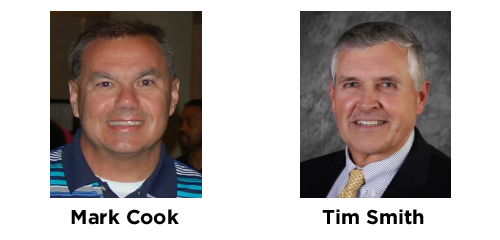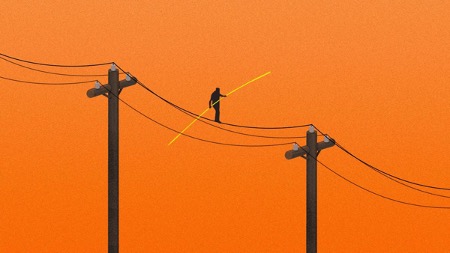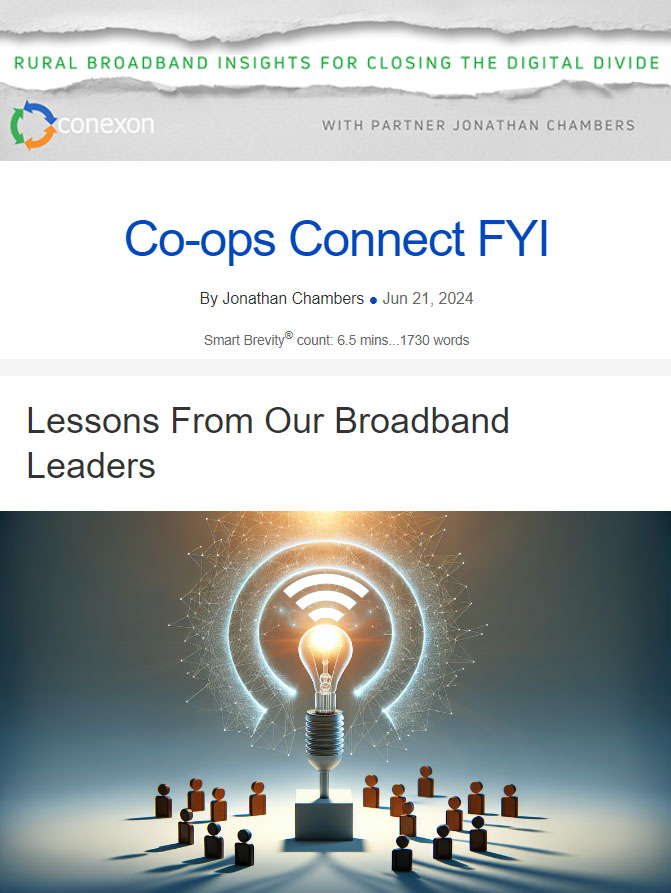Lessons From Our Broadband Leaders
June 21, 2024
Two weeks ago, I had the pleasure of sitting down for a conversation with two longtime colleagues in the broadband space:
- Mark Cook, Broadband Manager at Cumberland EMC in Tennessee
- Tim Smith, CEO at East Central Oklahoma Electric Cooperative

This discussion occurred in a Conexon webinar focused on the role of electric co-ops in delivering broadband access to 100% of members across rural America. My conversation with Tim and Mark was the first in the series.
We talked about broadband success strategies from smart grid to funding to construction innovations and more. If you have time to listen for the hour, I recommend it. (Request the webinar recording)
If not, here are the highlights of what you would learn from Tim and Mark, leaders of two wildly successful — and wildly different — electric co-op fiber broadband projects.
All in their own words.
Why Broadband Makes a Difference

“It took us 80 years to build out our electric network. We’re going to build out broadband in less than six years. When we use that analogy, people are patient.
Since completing our build to all members, and actually, all through the journey, we have gotten praise from our members, thanking us for what we’ve done and how we’ve done it and how appreciative they are to have high-speed internet services to their homes.
That’s the immediate benefit, but there’s more to this than internet. I want to leave that out there for those of you who are considering this.
There are so many benefits that we’re seeing – and that you would see – taking on a project of this nature that sets you up for a lot of success in the years to come, continuing to provide electric and internet services to your members.”
— Tim Smith, East Central Oklahoma Electric Cooperative
How Persistence Pays Off

“We launched broadband mainline construction in November 2019. We launched our first active service on May 1, 2020. Obviously, we all know what was going on around that time, but that only highlighted the importance of the project and the expediency that we needed to build and continue to build.
We were naïve – we thought we could build 1,400 miles per year, no problem. Some of the Conexon construction team expressed concern about that. But we kept pushing.
Here we are in June 2024 and:
- We will be finishing mainline construction at least a year ahead of schedule.
- We will have opened up to 100 percent of our service area by the end of this calendar year.
- We are just shy of 34,000 broadband subscribers, about a 36 percent take rate.
- We are a year and a half ahead of schedule on being net income positive, which is a huge financial milestone.
It’s been exciting.
We always compare this to what the cooperatives did in the 1930s, bringing electricity. I certainly wasn’t around then — most of us weren’t — but I always imagine it probably feels the same.”
— Mark Cook, Cumberland EMC
Why Electric Co-ops Make Sense

“The cooperative member experience is something that is on the front of our minds every day. If we have an outage, which is rare, we usually have it restored within minutes, not hours or even days. People see that and they recognize that.
Convincing our members who were unserved during the first wave of fiber installation was easier. Now we have to go back and convince those that have a cable company.
Why choose to switch to the electric cooperative? When customers ask, that I tell them:
‘Because we care. We care about you as a member and as a person. You own this cooperative. If I’m a member and I own a part of the company and I know they are going to take care of me, that’s reason enough for me to switch.’
I think straightforwardness, taking care of our members, and providing state-of-the-art technology and broadband speeds are going to win out.
It may take a little time to get there, but I think we’ll win out in the end.”
— Mark Cook, Cumberland EMC
How Funding Helps

“We never wanted or intended for the electric side to subsidize the broadband side.
But it takes a lot of money to build broadband. Winning federal money, first CAF II, then RDOF, and then ARPA, compounded our capability. Those awards were what was needed to give our board the assurance that we can make this work.
We were on track or ahead of track by the end of that first year from a financial model and a performance model. We indicated to the board that there would be other monies we would apply for, and anything we win would just help us that much more. We were basically going to double our balance sheet — that’s a big undertaking to do in such a short amount of time.
Had it not been for winning grant monies, we might not have done it.
CAF II came along at the right time. That got us started.
Every win that’s come after has just substantiated it:
- It’s helped our financial model.
- It’s helped us go faster.
- It’s now helping us build off-system.
We’re not stopping with just our member build. That’s exciting as well.
Off-system is a whole different world and a different timetable, but I fully expect we’ll be able to do it. It should not be something we can’t accomplish.”
— Tim Smith, East Central Oklahoma Electric Cooperative
How Smart Grid Helps

“Now that we’ve got our build to all of our members, we’re ramping up our Smart Grid initiative to connect as many downline devices as quickly as possible so we can provide a higher quality of electric service to our members.
This is again, in my opinion, actually a bigger benefit than internet itself.
As time goes on, all of us at the electric cooperatives are going to be graded on how well we’re providing our services. The expectation changes with every generation, and we are expected to do better and better and better.
Smart grid enables us to do that because of the way it’s designed and the way it’s built. It enables us to better serve our members, who are the very reason we are here. It’s the only reason we’re doing this now.
We don’t do it unless it’s good for our members, and this is good for our members.”
— Tim Smith, East Central Oklahoma Electric Cooperative
How Technology Helps

“Early on when we first started, we thought we would finish aerial construction without a problem, and underground would be the challenge. We pushed a lot of our high-density areas, the most underground, to the end of our build because we thought that would be our biggest time issue.
In reality, when we introduced the microduct method of installing, it was a gamechanger.
Microduct creates a pathway for the fiber by putting a smaller conduit (the fiber) inside a larger conduit (the electric conduit.) I tell people all the time it’s ten times faster and ten times cheaper. It’s just amazing.
It saved us a ton of money and a ton of time at the end of the day.”
— Mark Cook, Cumberland EMC
Why Electric Co-ops Do It Better

“Co-ops all have a local reputation. We’ve been here for 80+ years. We take care of our members. We respond to the outages. We’re known for all the things that are the very backbone of what we do.
Now that we’ve built to all our members, non-members come to us as communities, towns, or the general population, asking: ‘How can we get your internet?’
- They’re dissatisfied with their provider, and their provider’s service is subpar, let’s be honest. So they have come to us and begged us to come to them.
- We’ve indicated to them that it takes money to do this.
- We let them know we’re applying for money and if we win money in their area, we will come to their area.
And that’s what we’ve done. We won monies for some of the areas, and we are starting the process of engineering, design, and construction. Now we have a big part of our off-system area that we have planned to have complete by the end of this year.
From a financial modeling standpoint, we got grant money to help us get started, but we now have a financial model that’s proven we can make this work.
That’s why and that’s how we’re doing this. It’s at the request of the people in our communities.”
— Tim Smith, East Central Oklahoma Electric Cooperative
Why the Time to Act is Now

“To the co-ops and the boards that are thinking about ‘should we do it?’ or ‘can we afford to do it with the federal monies available?’ – I’m not sure you can afford not to do it. I’ll just say that.
There’s so much upside to this. Don’t look at it as just your members having internet. That’s a great benefit and your members are going to love you from now on because of it.
But there’s so much more that comes with this. If you can get a big chunk of this paid with federal grant monies that I don’t think we’ll ever see again, please take a hard look at it.
It’s the right thing to do. Our members expect us to do things that benefit them. They own us, and we’re only there for them.
If we can do something that benefits them in so many ways – and this is more than internet – then I’ve said it many times. This is the right decision to make.”
— Tim Smith, East Central Oklahoma Electric Cooperative
Ready for More Insights?

Our next webinar is Thursday, June 27 at 11:00 CT. I’ll be joined by two more visionary co-op leaders:
- Wendy Sellers, Washington EMC, Georgia
- Ron Barnes, Coast EPA, Mississippi
In addition to sharing their success stories, Wendy and Ron will expound on different models of network ownership and operations that allow a co-op to participate in broadband at whatever level makes the most sense.
I hope you’ll join us. Register now.
